Chapter 28- Reproductive System
1/193
There's no tags or description
Looks like no tags are added yet.
Name | Mastery | Learn | Test | Matching | Spaced |
|---|
No study sessions yet.
194 Terms
The reproductive system includes all of the following except
A) gonads and external genitalia.
B) ducts that receive and transport the gametes.
C) accessory glands and organs that secrete fluids.
D) organs for copulation.
E) glands and organs that produce and store urine.
E
The reproductive organ that produces gametes is called a
A) duct.
B) gland.
C) gonad.
D) womb.
E) girdle.
C
The male gonad is called a(n)
A) seminal vesicle.
B) epididymis.
C) rete.
D) testis.
E) prostate.
D
Sperm are moved along the ductus deferens (vas deferens) by
A) hydrostatic force.
B) ciliary action.
C) peristaltic contractions.
D) suction.
E) hydraulic action.
C
Arrange the four structures listed below into the order in which sperm pass from the testis to the external urethral orifice.
1. ductus deferens
2. urethra
3. ejaculatory duct
4. epididymis
A) 1, 3, 4, 2
B) 4, 3, 1, 2
C) 4, 1, 2, 3
D) 4, 1, 3, 2
E) 1, 4, 3, 2
D
The organ that monitors and adjusts the composition of tubular fluid, recycles damaged sperm and is the site of sperm maturation is the
A) ductus deferens.
B) rete testis.
C) seminal gland (seminal vesicle).
D) epididymis.
E) prostate gland.
D
The organ that carries sperm from the epididymis to the urethra is the
A) ductus deferens (vas deferens).
B) epididymis.
C) seminal gland (seminal vesicle).
D) ejaculatory duct.
E) corpus cavernosum.
A
Inward projections of the tunica albuginea, known as septa testis, divide the testis into
A) seminiferous tubules.
B) straight tubules.
C) lobules.
D) rete testis.
E) the epididymis and the testis proper.
C
Straight tubules originate at the seminiferous tubules and form a network of passageways called the
A) epididymis.
B) ductus deferens.
C) rete testis.
D) efferent ducts.
E) vas deferens.
C
The spermatic cord is
A) a bundle of tissue that contains the ductus deferens, blood vessels, nerves, and lymphatics that serve the testis.
B) a narrow opening that links the scrotal chamber with the peritoneal cavity.
C) the external marking of the boundary between the two chambers of the scrotum.
D) a layer of smooth muscle in the skin of the scrotal sac.
E) a dense layer of connective tissue that surrounds the testis.
A
Interstitial endocrine cells produce
A) sperm.
B) inhibin.
C) nutrients.
D) testosterone.
E) androgen-binding protein.
D
Sperm production occurs in the
A) ductus deferens.
B) seminiferous tubules.
C) epididymis.
D) seminal glands (seminal vesicles).
E) rete testis.
B
The organ that produces a secretion that contains fructose, prostaglandins, and fibrinogen is the
A) prostate gland.
B) bulbo-urethral gland.
C) seminal gland (seminal vesicle).
D) corpus cavernosum.
E) preputial gland.
C
The organ that surrounds the urethra and produces an alkaline secretion is the
A) seminal gland (seminal vesicle).
B) bulbo-urethral gland.
C) prostate gland.
D) preputial gland.
E) Bartholin's gland.
C
The small paired structures at the base of the penis that secrete a thick, alkaline mucus are the
A) seminal vesicles.
B) prostate glands.
C) preputial glands.
D) Bartholin glands.
E) bulbo-urethral glands.
E
Semen contains all of the following except
A) sperm.
B) seminal fluid.
C) prostaglandins.
D) spermatogonia.
E) fibrinogen.
D
The external marking of the boundary between the two testes is the
A) spermatic cord.
B) raphe.
C) tunica albuginea.
D) acrosome.
E) dartos muscle.
B
The organ that delivers semen into the female reproductive tract is the
A) urethra.
B) ejaculatory duct.
C) penis.
D) corpus cavernosum.
E) corpus spongiosum.
C
The fold of skin that covers the glans penis is the
A) ejaculatory duct.
B) foreskin.
C) corpus cavernosum.
D) corpus spongiosum.
E) penile urethra.
D
The erectile tissue that surrounds the urethra is the
A) membranous urethra.
B) penile urethra.
C) glans penis.
D) corpus spongiosum.
E) corpora cavernosa.
D
The paired erectile bodies in the penis are the
A) membranous urethra.
B) penile urethra.
C) corpus spongiosum.
D) corpora cavernosa.
E) foreskin.
D
Which of the following glands contributes the most volume to semen?
A) prostate gland
B) rete testis
C) seminal gland (seminal vesicle)
D) bulbo-urethral gland
E) foreskin
C
The delicate layer of serous membrane that covers the testis is called the
A) median raphe.
B) tunica vaginalis.
C) tunica albuginea.
D) dartos.
E) lamina propria.
B
The PSA test is used for diagnosis of
A) testicular cancer.
B) penile cancer.
C) prostatitis.
D) premature puberty.
E) prostate cancer.
E
A typical ejaculation releases approximately ________ sperm.
A) 1 million
B) 250 million
C) 100,000
D) 20 million
E) 800 million
B
If the prostate stopped secreting fluid, this would result in semen
A) that lacked sperm.
B) with a higher than normal pH.
C) with less fructose.
D) with no mucus.
E) that was rich in prostaglandins.
B
A vasectomy would interfere with a man's ability to
A) secrete testosterone.
B) make sperm.
C) ejaculate.
D) produce semen.
E) deliver sperm to the ejaculatory duct.
E
Contraction of the cremaster muscles
A) tenses the scrotum.
B) pulls the testes closer to the body cavity.
C) propels sperm through the urethra.
D) moves sperm through the ductus deferens.
E) tenses the scrotum and pulls the testes closer to the body cavity.
E
Contraction of the dartos muscle
A) tightens the scrotum.
B) produces an erection.
C) propels sperm through the urethra.
D) moves sperm through the ductus deferens.
E) initiates seminal emission.
A
Functions of the accessory glands of the male reproductive system include all of the following except
A) production of sperm.
B) meeting the nutrient needs of sperm for motility.
C) propelling sperm and fluids along the reproductive tract.
D) producing buffers.
E) activating the sperm.
A
A normal sperm count ranges from approximately ________ sperm per milliliter.
A) 10 million
B) 100-150 million
C) 1-2 million
D) 500 million
E) 20-100 million
E
Why are inguinal hernias generally associated with males?
A) Males have a gene on the Y chromosome that codes for inguinal hernia, whereas women do not have the Y chromosome.
B) Women have a thicker set of skeletal muscles in the abdominal wall compared to men.
C) Males work more strenuously than women, thereby damaging the abdominal wall.
D) Males have a canal through the abdominal wall that the testes move through, and it often does not close up properly.
E) The groin area is genetically weaker in men than in women because of the presence of the penis and testes.
D
The portion of the urethra that passes through the pelvic cavity floor is called the
A) membranous urethra.
B) bulbo-urethral.
C) penile urethra.
D) ureter.
E) prostatic urethra.
E
The portion of the urethra that penetrates the urogenital diaphragm is the
A) membranous urethra.
B) penile urethra.
C) corpus spongiosum.
D) spongy urethra.
E) vascular urethra.
A
The surgical removal of the foreskin is called
A) circumcision.
B) orchidectomy.
C) tubectomy.
D) vasectomy.
E) pupectomy.
A
The ________ carries fluid from the seminal gland (seminal vesicle) through the prostate.
A) ejaculatory duct
B) vas deferens
C) ductus deferens
D) epididymis
E) rete
A
The ductus deferens passes through the ________ to enter the pelvic cavity.
A) canaliculi
B) mesiobuccal canal
C) epididymis
D) inguinal canal
E) urinary bladder
D
The organ inferior to the urinary bladder and contains the urethra in the middle is the
________ gland.
A) prostate
B) bulbo-urethral
C) Cowper's
D) seminal vesicle
E) seminiferous tubular
A
The cremaster muscle can raise and lower the testes to regulate
A) temperature.
B) expansion.
C) erection.
D) pH.
E) size.
A
The pampiniform plexus of the testicular vein is found within the
A) epididymis.
B) raphe.
C) spermatic cord.
D) cremaster muscle.
E) rete testis.
C
For normal sperm development, the testes must be kept about
A) the same temperature as the brain.
B) 1.1°C cooler than core body temperature.
C) 1.1°C warmer than core body temperature.
D) 4.8°C cooler than core body temperature.
E) 4.8°C warmer than core body temperature.
B
Each lobule contains approximately ________ seminiferous tubules.
A) 4
B) 100
C) 400
D) 800
E) 1500
D
The rete testis is connected to the epididymis by
A) efferent ductules.
B) the spermatic cord.
C) the tunica albuginea.
D) the tunica vaginalis.
E) the straight tubules.
A
Frank is experiencing difficulty urinating, painful urination, low back pain and a slight fever. The doctor prescribes antibiotics and Frank recovers. It is likely that Frank suffered from
A) impotence.
B) prostate cancer.
C) prostatitis.
D) a vasectomy.
E) a circumcision.
C
Which of the following does not contribute to seminal fluid?
A) seminal glands
B) prostate gland
C) nurse cells and epididymis
D) spermatic cords
E) bulbo-urethral glands
D
Which of the following are not important enzymes found in seminal fluid?
A) proteases, help dissolve mucus in the vagina
B) seminalplasmin, an antibiotic enzyme
C) fibrinolysin, dissolves the semen clot after 15-30 minutes
D) coagulating enzymes, form a semen clot after ejaculation
E) hydrolases, remove water and concentrate semen
E
The erectile tissue that extends down into the glans penis is the
A) corpus spongiosum.
B) corpora cavernosa.
C) preputial glands.
D) smegma.
E) crus of penis.
A
Kevin has been experiencing difficulty urinating now that he is over the age of 60. The doctor examines his prostate gland and finds no evidence of inflammation. Furthermore, Kevin's PSA test is normal. It is most likely that Kevin is suffering from
A) impotence.
B) prostate cancer.
C) benign prostatic hypertrophy.
D) prostatitis.
E) male climacteric.
C
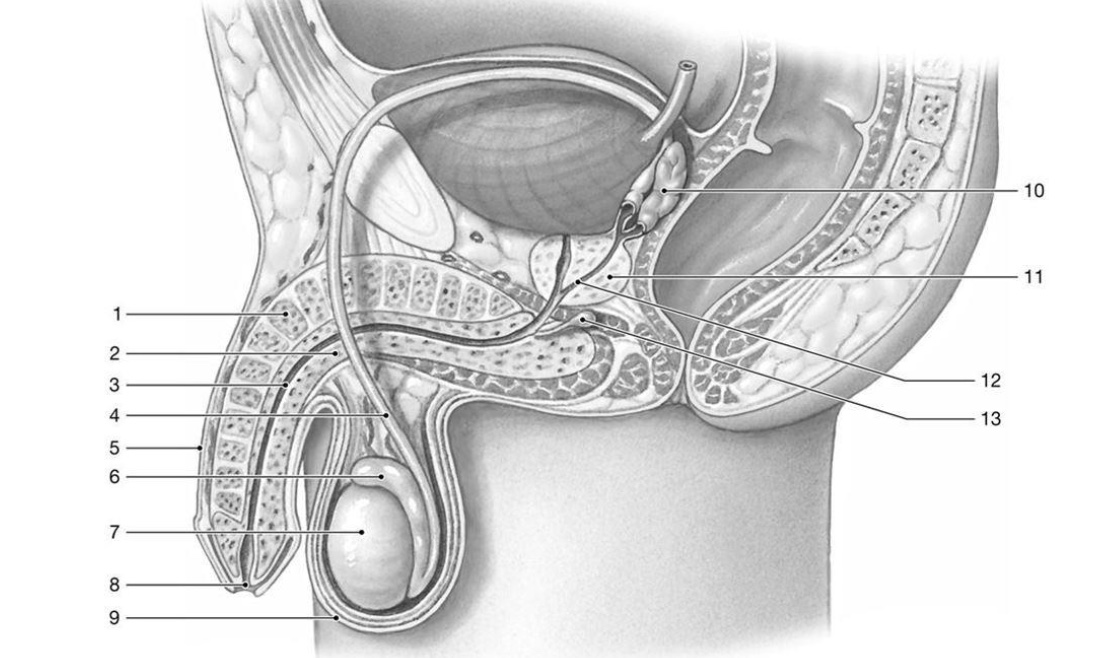
Identify the structure labeled "11."
A) bulbo-urethral gland
B) prostate gland
C) seminal gland (seminal vesicle)
D) epididymis
E) ductus deferens
B
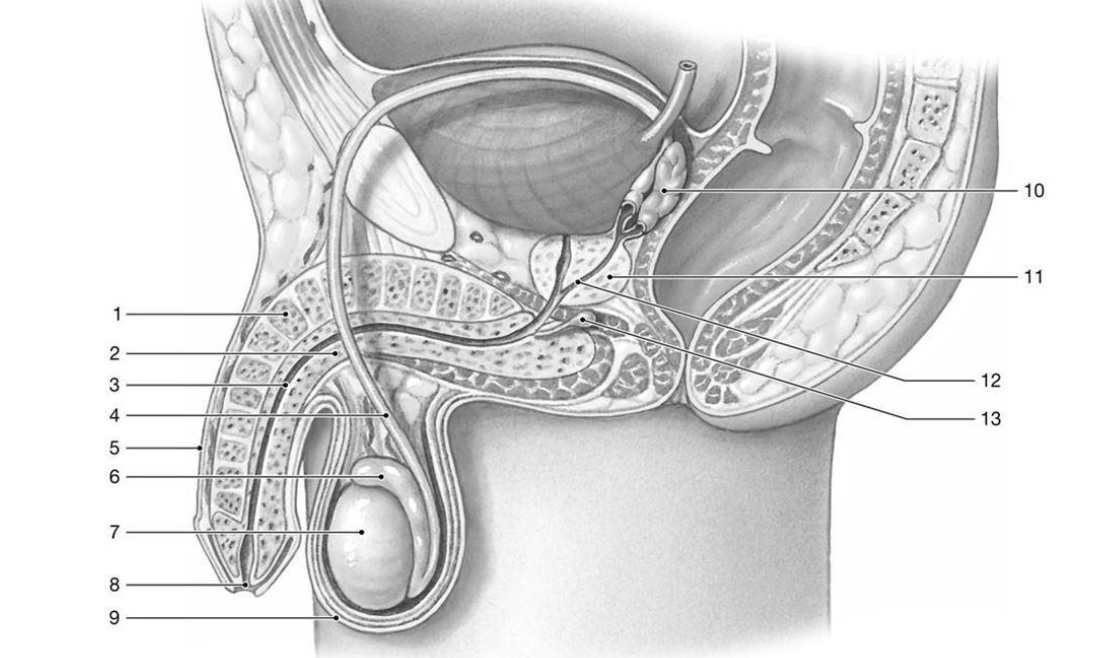
Identify the structure labeled "3."
A) corpora cavernosa
B) prostatic urethra
C) corpus spongiosum
D) spongy urethra
E) ejaculatory duct
D
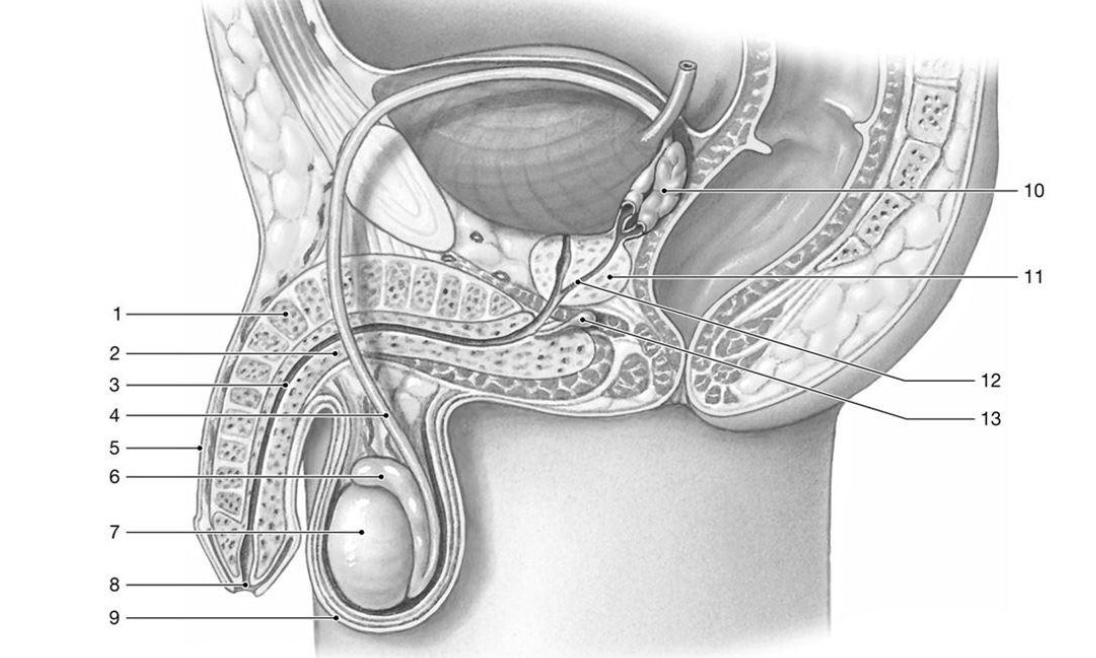
Identify the structure labeled "13."
A) bulbo-urethral gland
B) prostate gland
C) seminal gland (seminal vesicle)
D) epididymis
E) ductus deferens
A
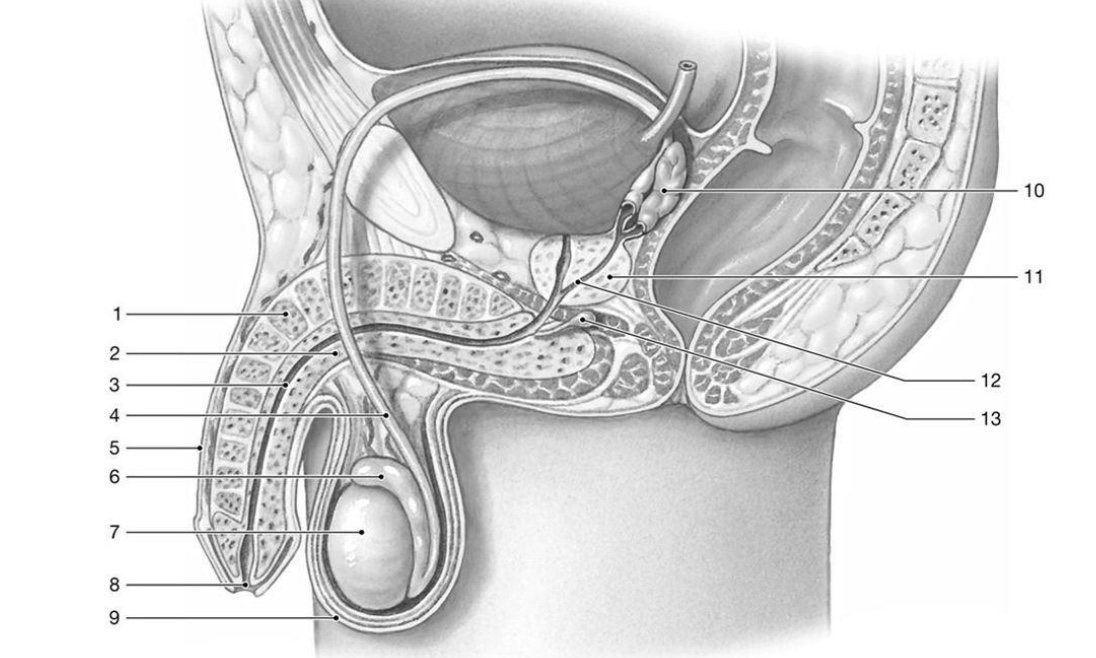
Identify the structure labeled "4."
A) testis
B) prostate gland
C) seminal gland (seminal vesicle)
D) epididymis
E) ductus deferens
E

Identify the structure that produces a fructose-rich fluid.
A) 9
B) 10
C) 11
D) 12
E) 13
B

Identify the structure labeled "12."
A) prostatic urethra
B) ejaculatory duct
C) ductus deferens
D) vas deferens
E) membranous urethra
B
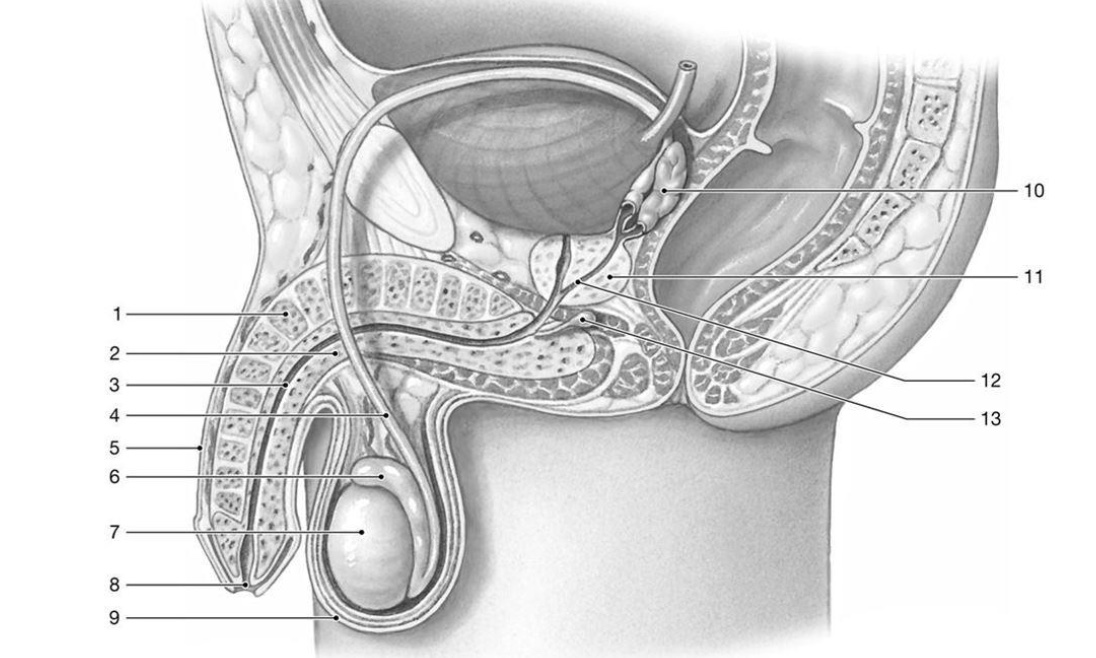
Identify the structure labeled "6."
A) ejaculatory duct
B) seminiferous tubule
C) ductus deferens
D) epididymis
E) testis
D
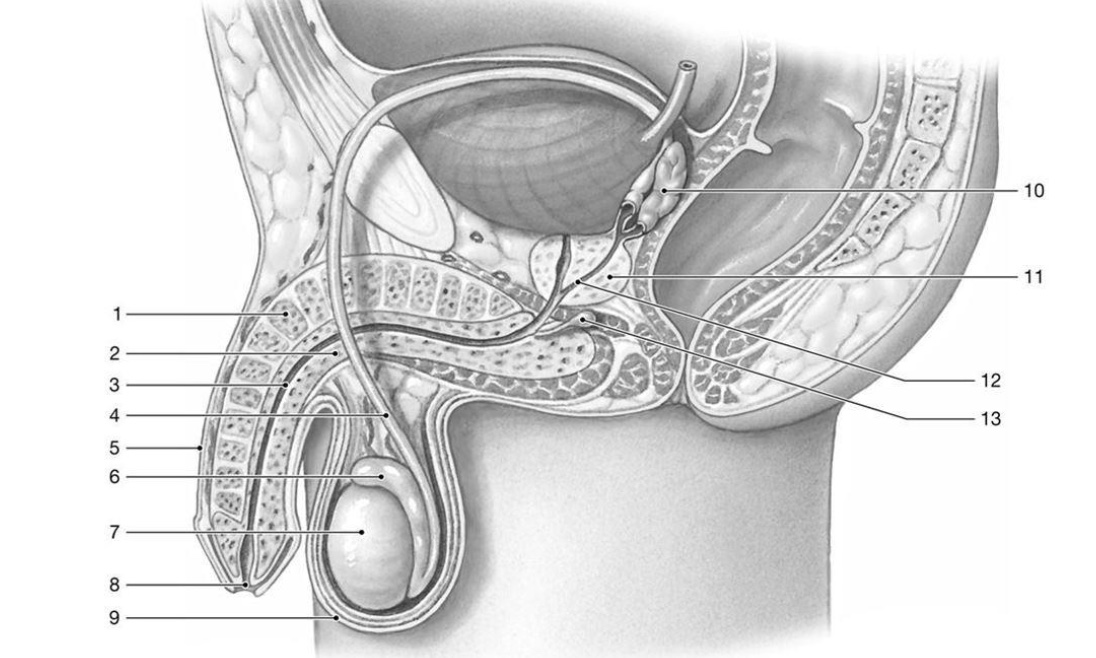
Identify the structure labeled "1."
A) membranous urethra
B) ejaculatory duct
C) corpora cavernosa
D) corpus spongiosum
E) prostatic urethra
C
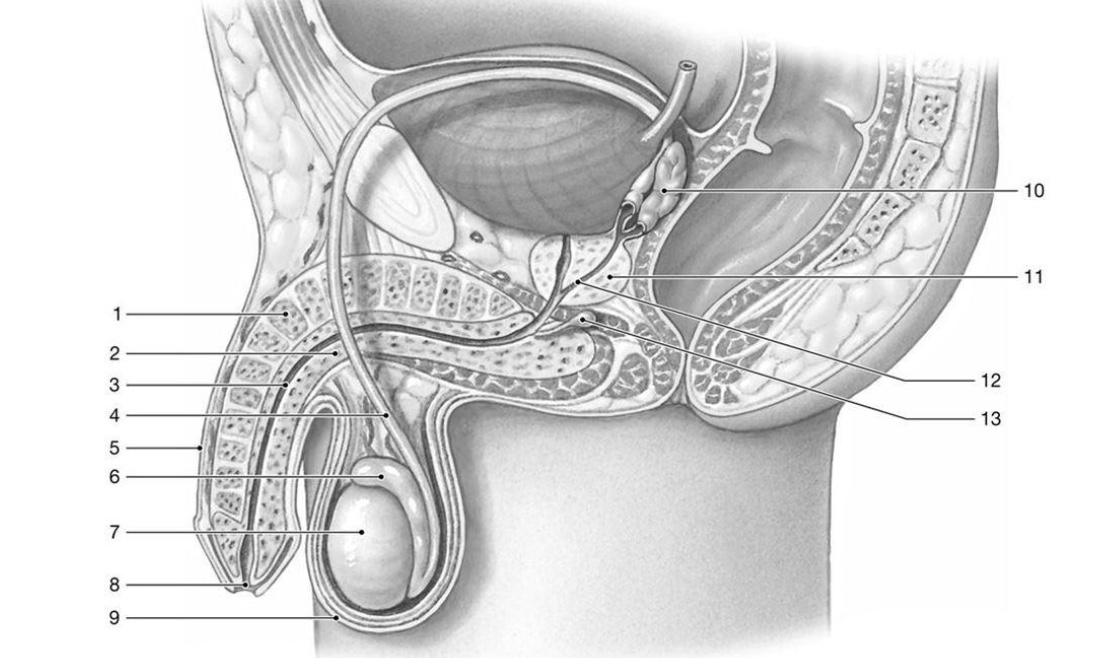
Identify the structure labeled "9."
A) scrotum
B) cremaster muscle
C) ductus deferens
D) testis
E) foreskin
A
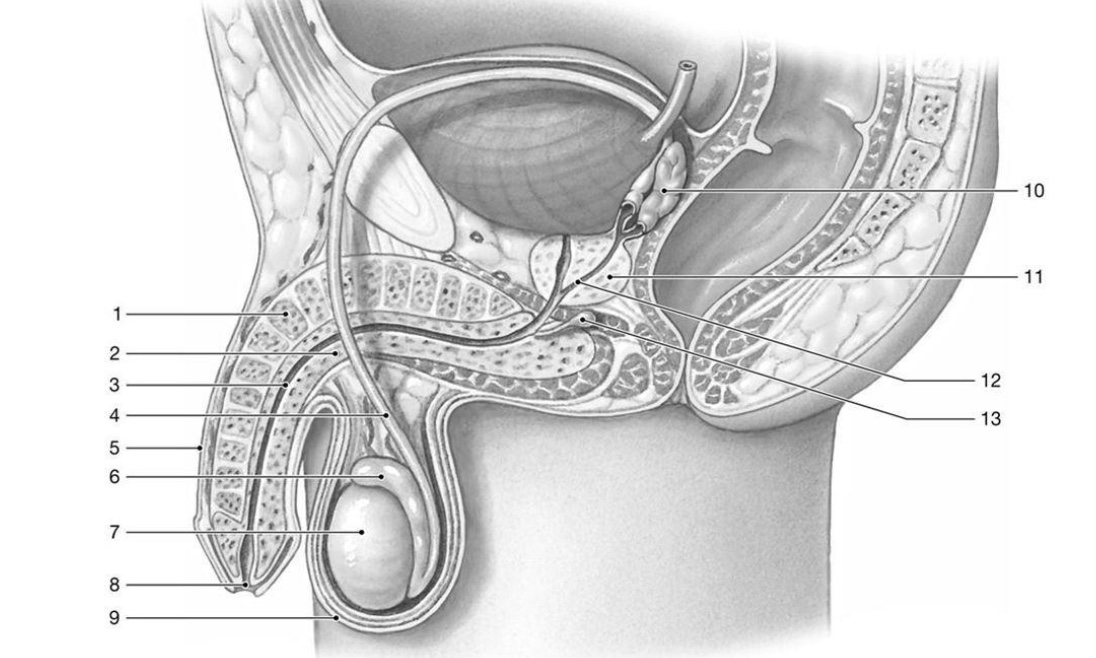
Identify the structure labeled "2."
A) penile urethra
B) ejaculatory duct
C) corpora cavernosa
D) corpus spongiosum
E) membranous urethra
D
The nurse cells of the seminiferous tubules do all of the following except
A) maintain the blood testis barrier.
B) support spermiogenesis.
C) secrete inhibin.
D) secrete testosterone.
E) secrete androgen-binding protein.
D
Sperm develop from stem cells called
A) spermatogonia.
B) primary spermatocytes.
C) secondary spermatocytes.
D) spermatids.
E) sperm.
A
When spermatogonia divide, the daughter cells are called
A) spermatogonia.
B) spermatocytes.
C) spermatids.
D) sperm.
E) Sertoli cells.
B
The cells that are formed during spermatogenesis by meiosis I are called
A) spermatogonia.
B) primary spermatocytes.
C) secondary spermatocytes.
D) spermatids.
E) sperm.
C
The process of spermiogenesis produces
A) spermatogonia.
B) primary spermatocytes.
C) secondary spermatocytes.
D) spermatids.
E) sperm.
E
The role of FSH in males is to
A) stimulate the interstitial endocrine cells to produce testosterone.
B) stimulate the growth of male accessory glands.
C) initiate sperm production in the testes.
D) develop and maintain secondary sex characteristics.
E) influence sexual behaviors and sex drive.
C
The pituitary hormone that stimulates the interstitial endocrine cells to secrete testosterone is
A) FSH.
B) LH.
C) ACTH.
D) GnRH.
E) GH.
B
A primary spermatocyte matures into ________ spermatids having ________ chromosomes.
A) millions of; 46
B) four; 23
C) one; 46
D) millions of; 23
E) four; 46
B
The special type of cell division required to produce gametes is called
A) mitosis.
B) meiosis.
C) maturation.
D) capacitation.
E) fertilization.
B
Sperm are functionally matured within the
A) epididymis.
B) straight tubules.
C) rete testes.
D) seminiferous tubules.
E) seminal gland (seminal vesicle).
A
During meiosis I, maternal and paternal chromosomes come together during the process called ________ to form a ________.
A) synapsis; chromatid
B) prophase I; chromatid
C) synapsis; spermatid
D) metaphase II; tetrad
E) synapsis; tetrad
E
In a mature human sperm, the
A) acrosome is next to the flagellum.
B) midpiece contains the chromosomes.
C) tail contains the mitochondria.
D) head contains 23 chromosomes.
E) head is diploid.
D
Secondary spermatocytes each contain
A) 23 chromosomes.
B) 23 pairs of chromosomes.
C) twice the diploid number of chromosomes.
D) 46 pairs of chromosomes.
E) 46 chromosomes.
A
Testosterone is secreted by the
A) hypothalamus.
B) anterior pituitary.
C) nurse cells.
D) interstitial endocrine cells.
E) adrenal cortex
D
Where in the male reproductive system would you expect to find the most mature sperm?
A) in the seminiferous tubules
B) in the head of the epididymis
C) near the tail of the epididymis
D) in the seminal gland
E) in the prostate gland
C
A boy has a genetic mutation such that FSH is not produced, but LH is normal. After the boy grows to maturity, it is likely he will
A) not develop secondary sex characteristics.
B) be sterile.
C) be impotent.
D) have impaired function of the interstitial endocrine cells.
E) produce large amounts of inhibin.
B
A male bodybuilder starts taking injections of testosterone (an anabolic steroid on a daily basis. After three weeks, you expect to observe all of the following, except
A) increased sex drive.
B) decreased levels of GnRH.
C) decreased levels of LH and FSH.
D) increased muscle mass.
E) decreased nurse cell stimulation.
E
Spermatids mature into sperm by the process of
A) spermiogenesis.
B) meiosis II.
C) spermatogenesis.
D) cytokinesis.
E) meiosis I.
A
The ________ is the part of the sperm that contains the DNA.
A) head
B) neck
C) acrosome
D) zona pellucida
E) corona radiata
A
The middle piece of the sperm contains the ________ in a spiral arrangement.
A) nucleosome
B) chromosomes
C) mitochondria
D) flagella
E) acrosome
C
The ________ of a sperm contains the enzymes essential for fertilization.
A) acrosome
B) flagellum
C) nucleosome
D) neck
E) nucleus
A
The most important androgen is
A) dihydrotestosterone.
B) androstenedione.
C) dehydroepiandrosterone.
D) progesterone.
E) testosterone.
E
The hormone that stimulates spermatogenesis in males is
A) PTH.
B) FSH.
C) LH.
D) GH.
E) MSH.
B
The interstitial endocrine cells in the testes produce
A) dihydrotestosterone.
B) androstenedione.
C) growth hormone.
D) progesterone.
E) testosterone.
E
The level of testosterone is kept high locally in the seminiferous tubules by activation of
A) LH.
B) FSH.
C) androgen-binding protein.
D) dihydrotestosterone.
E) GnRH.
C
Which of the following is not found within the seminiferous tubule?
A) spermatogonia
B) spermatocytes
C) nurse cells
D) interstitial endocrine cells
E) spermatids
D
The complete process of spermatogenesis takes approximately how many days?
A) 14
B) 28
C) 45
D) 64
E) 120
D
At the end of meiosis II, one spermatogonium has formed
A) 2 fully functional sperm.
B) 4 fully functional sperm.
C) 2 spermatids.
D) 4 spermatids.
E) 1 sperm and 3 polar bodies.
D
Which of the following is not true of meiosis I?
A) reductional division occurs
B) 4 haploid gametes are formed
C) number of chromosomes is reduced from 46 to 23 in daughter cells
D) diploid daughter cells form
E) daughter cells contain sister chromatids
B
The role of inhibin in male reproduction is to
A) decrease the production of testosterone.
B) keep testosterone levels high inside the seminiferous tubule.
C) stimulate the testes to descend.
D) stimulate spermiogenesis.
E) provide negative feedback regulation of FSH and GnRH secretion.
E
Which of the following descriptions best matches the term endometrium?
A) thick layer of smooth muscle cells
B) supports the uterus anteriorly
C) supports the uterus laterally
D) consists of a functional zone and a basilar zone of epithelium
E) After ovulation, the ovum is captured by it.
D
The broad ligament is a(n)
A) extensive mesentery that encloses the ovaries, uterine tubes, and uterus.
B) thickened fold of mesentery that supports and stabilizes the position of the ovary.
C) pocket formed between the posterior wall of the uterus and the anterior surface of the rectum.
D) structure that anchors the ovary to the recto-uterine pouch.
E) structure that extends from the lateral surface of the ovary to the pelvic wall.
A
The organ that transports the ovum to the uterus is the
A) uterosacral ligament.
B) vagina.
C) uterine (Fallopian) tube.
D) infundibulum.
E) myometrium.
C
The organ that provides mechanical protection and nutritional support for the developing embryo is the
A) vagina.
B) uterine tube.
C) ovary.
D) uterus.
E) cervix.
D
The round ligaments extend from the
A) base of the uterus and vagina to the lateral walls of the pelvis.
B) lateral surface of the uterus to the anterior surface of the sacrum.
C) lateral margins of the uterus, through the inguinal canal to the external genitalia.
D) body of the uterus to the fundus.
E) cervix of the uterus to the vagina.
C
The inferior one-third portion of the uterus that projects into the vagina is the
A) isthmus.
B) vaginal fornix.
C) fundus.
D) body.
E) cervix.
E
The thick muscular layer of the uterus is the
A) endometrium.
B) perimetrium.
C) myometrium.
D) uterometrium.
E) sarcometrium.
C
Which of the following statements concerning the vagina is false?
A) It serves as a passageway for the elimination of menstrual fluids.
B) It receives the penis during sexual intercourse.
C) It holds sperm prior to their passage to the uterus.
D) It forms the lower portion of the birth canal.
E) It loses a portion of its lining during menses.
E
The vagina is
A) lined by simple columnar epithelium rich in goblet cells.
B) similar to the inner lining of the uterus.
C) another term for the cervix.
D) a muscular tube extending between the uterus and the external genitalia.
E) a muscular tube extending between the uterus and the anus.
D
The vulva includes all of the following except the
A) mons pubis.
B) vagina.
C) labia minora.
D) clitoris.
E) labia majora.
B
The space bounded by the labia minora is the
A) vaginal fornix.
B) vestibule.
C) hymen.
D) clitoris.
E) isthmus.
B
Fatty folds of skin that encircle and partially conceal the labia minora and vestibule are the
A) fornices.
B) ampullae.
C) labia majora.
D) mons pubis.
E) vestibular arches.
C